Tom Wallace, 1874-1961
The Tom Wallace Papers contains 23 cubic feet of Wallace’s correspondence, speeches and other material, documenting the prodigious career of this native Kentuckian who served as a journalist, a conservationist, and a promoter of friendship between the Americas.
By Noah Huffman
Special Collections Assistant
About |
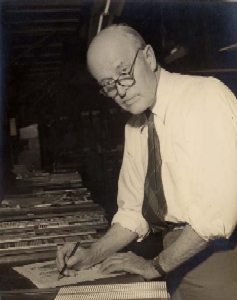 With 23 cubic feet of Wallace’s correspondence, speeches and other material, the collection documents
the prodigious career of this native Kentuckian whose intellect, vigilance and tenacity garnered him
national recognition on three fronts – as a journalist, a conservationist and a promoter of friendship
between the Americas. Upon his death in 1961, The New York Times lauded Wallace as “a believer in the
editorial crusade” whose “vigorous pen” waged two major campaigns during his lifetime, “the fight for
conservation of the nation’s natural resources and a long campaign for the betterment of relations between
North and South America.” Fortunately, as part of the 20th Century Initiative, The Filson can now provide
scholars of journalism, conservation history and Latin American relations with access to this important collection
from the last century.
With 23 cubic feet of Wallace’s correspondence, speeches and other material, the collection documents
the prodigious career of this native Kentuckian whose intellect, vigilance and tenacity garnered him
national recognition on three fronts – as a journalist, a conservationist and a promoter of friendship
between the Americas. Upon his death in 1961, The New York Times lauded Wallace as “a believer in the
editorial crusade” whose “vigorous pen” waged two major campaigns during his lifetime, “the fight for
conservation of the nation’s natural resources and a long campaign for the betterment of relations between
North and South America.” Fortunately, as part of the 20th Century Initiative, The Filson can now provide
scholars of journalism, conservation history and Latin American relations with access to this important collection
from the last century.
Born in Hurricane, Crittenden County, Kentucky, in 1874, Tom Wallace received his early instruction
from a family tutor before attending Weaver’s Business College in Louisville and eventually Randolph Macon College
in Ashland, Virginia. Despite his academic promise, Wallace left school early and took a series of brief jobs as
a bookkeeper in Shelbyville, Ky., 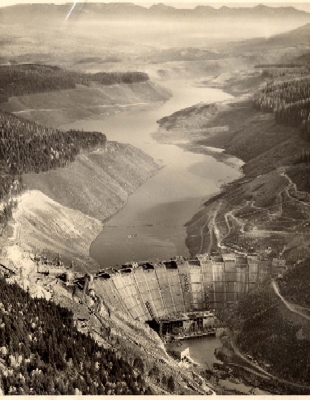 Richmond, Va., and New York City. It was during this period that he discovered
he “hated all kinds of business,” an attitude that became increasingly apparent with age. Swearing off the business
world, young Wallace and two adventurous friends set sail down the coast of Florida on a rickety catboat he
named the “Bluegrass.” As he recalled in an unpublished autobiography held at The Filson, the natural beauty of
the landscape and the abundance of wildlife he encountered left an indelible impression that later influenced his
career-long advocacy of scenic and wildlife preservation.
Richmond, Va., and New York City. It was during this period that he discovered
he “hated all kinds of business,” an attitude that became increasingly apparent with age. Swearing off the business
world, young Wallace and two adventurous friends set sail down the coast of Florida on a rickety catboat he
named the “Bluegrass.” As he recalled in an unpublished autobiography held at The Filson, the natural beauty of
the landscape and the abundance of wildlife he encountered left an indelible impression that later influenced his
career-long advocacy of scenic and wildlife preservation.
Returning home to Kentucky in 1900, the 26-year-old Wallace sought a new career path. He chose journalism and talked his way into an unpaid position as a police reporter at the Louisville Times, writing the column “Little Dramas of the Police Court.” Six weeks later the Louisville Dispatch offered Wallace a paid position, the first of several brief reporting jobs he held while honing his skills as a newspaperman. Eventually, Wallace landed back at the Louisville Times as its Washington correspondent. Impressed by his work for the Times, legendary editor Henry Watterson hired the relatively inexperienced Wallace as the youngest member of the Courier-Journal editorial staff in 1905. Over the next several years as an associate editor, Wallace studied under Watterson and, like his mentor, developed a reputation for boldness and brevity in his editorials. Echoing Watterson’s editorial philosophy, Wallace would later remark that “editorials should be no longer than a pencil,” and “an editorial page without spunk is bunk.”
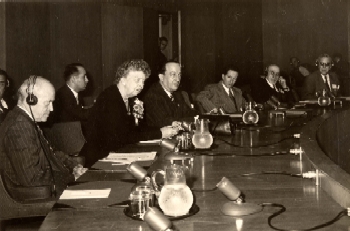 In 1923, two years after the death of his revered chief, Wallace became
the head of the Louisville Times editorial page. He was named editor by owner/publisher Robert Worth Bingham
in 1930, where he remained until the Times’ age requirement forced him to retire in 1948. Although unhappy
about his early departure, Wallace continued to contribute to the Times as editor emeritus, in addition to authoring
numerous editorials and articles for national publications. During Wallace’s tenure and under owners R.W. and
Barry Bingham, the Times rose to national prominence. In recognition of Wallace’s leadership and integrity, he
received numerous professional honors, including serving as president of the American Society of Newspaper Editors from
1940 to 1941.
In 1923, two years after the death of his revered chief, Wallace became
the head of the Louisville Times editorial page. He was named editor by owner/publisher Robert Worth Bingham
in 1930, where he remained until the Times’ age requirement forced him to retire in 1948. Although unhappy
about his early departure, Wallace continued to contribute to the Times as editor emeritus, in addition to authoring
numerous editorials and articles for national publications. During Wallace’s tenure and under owners R.W. and
Barry Bingham, the Times rose to national prominence. In recognition of Wallace’s leadership and integrity, he
received numerous professional honors, including serving as president of the American Society of Newspaper Editors from
1940 to 1941.
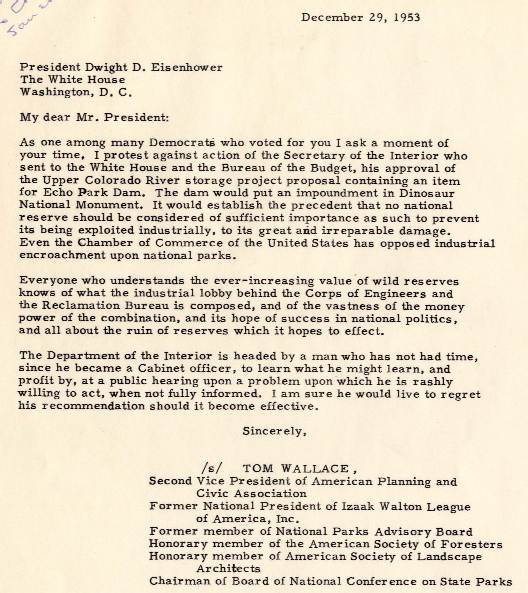 Although
recognized as one of the country’s most hard-hitting and respected editors, Wallace is best remembered for his
career-long fight to preserve the nation’s natural resources and scenic landscapes. At a time when newspapers and journalists immensely
influenced public opinion, Wallace used his fame as editor to both popularize and energize a nascent conservation
movement that had previously consisted of only a few elite “nature enthusiasts.”
Although
recognized as one of the country’s most hard-hitting and respected editors, Wallace is best remembered for his
career-long fight to preserve the nation’s natural resources and scenic landscapes. At a time when newspapers and journalists immensely
influenced public opinion, Wallace used his fame as editor to both popularize and energize a nascent conservation
movement that had previously consisted of only a few elite “nature enthusiasts.”
As a conservationist, Wallace’s
greatest triumph came in 1930 after he
spearheaded a five-year campaign to
prevent the construction of a hydroelectric
dam at Cumberland Falls.
Publishing over 200 editorials and
delivering countless speeches against
the Samuel Insull project, Wallace
unearthed a groundswell of public support
for saving the falls, thus persuading
native Kentuckian T. Coleman
duPont to purchase the Cumberland
Falls tract and donate it to the state
before the Federal Power Commission
could approve the dam. A legislative
fight quickly ensued, pitting Wallace
and his supporters against Governor
Flem Sampson and his pro-dam coalition.
Largely due to Wallace’s relentless
pressure, the Senate eventually voted
to approve the duPont Gift Acceptance
Bill over Sampson’s veto, effectively
saving the falls for future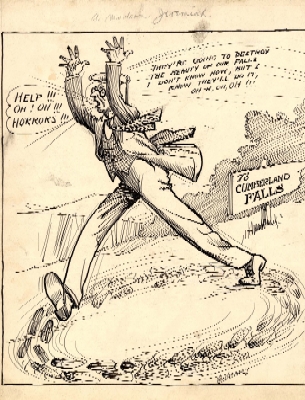 generations
of Kentuckians. Ultimately the victory
at Cumberland Falls won Wallace wide
acclaim in conservation circles and
effectively initiated him into the small
but emergent national movement.
generations
of Kentuckians. Ultimately the victory
at Cumberland Falls won Wallace wide
acclaim in conservation circles and
effectively initiated him into the small
but emergent national movement.
Through the “Cumberland Falls Fight” Wallace gained contacts with prominent conservationists nationwide from National Park Service Directors Stephen Mather and Horace Albright, to lay leaders like Gifford Pinchot and J.N. “Ding” Darling. These valuable contacts, coupled with his flair for argument and his unique position as editor of a respected newspaper, catapulted Wallace to the forefront of American conservation. In a 1957 letter, National Park Service Director Newton Drury dubbed him “the supreme philosopher in this business.”
Because of his influence, a series of
organizations coveted Wallace’s leadership. In 1946 he was elected president
of the Izaak Walton League of
America, one of the earliest and most
influential conservation organizations.
In addition, he served as chairman
of the National Conference on State
Parks, Vice-President of the American
Planning and Civic
Association, and on
the Advisory Board
to the National Parks
Service. In these
various capacities,
Wallace lobbied
against high dams,
stream pollution and
strip mining, and
formulated policy for
the National Park 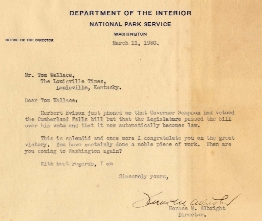 Service. Some 20
years after Cumberland
Falls, Wallace
led a campaign
against the proposed
Echo Park Dam in
Colorado during
the 1950s. After nearly a decade of
heated debate, Wallace and his fellow
preservationists convinced Secretary of
the Interior Douglas McKay to abandon
the project, one of the watershed
events in conservation history.
Service. Some 20
years after Cumberland
Falls, Wallace
led a campaign
against the proposed
Echo Park Dam in
Colorado during
the 1950s. After nearly a decade of
heated debate, Wallace and his fellow
preservationists convinced Secretary of
the Interior Douglas McKay to abandon
the project, one of the watershed
events in conservation history.
Throughout his life, Wallace argued that “preservation is our purpose,” abhorring “artificial improvements” of any kind – a stance that often brought him into conflict with more moderate conservationists. In recognition of his many achievements the University of Louisville established the Tom Wallace Chair of Conservation in 1956. The Tom Wallace Lake in Jefferson County Memorial Forest was also named in his honor.
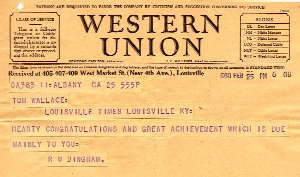 In addition to his duties as editor
and amateur conservationist, Wallace
lent his talents to promoting better dialogue
between the Americas. He wrote
that for too long “we have indulged
a superiority complex with regard to
Latin Americans, who, as a result
have shrugged their shoulders.”
To combat this prevailing attitude,
Wallace and several other journalists
founded the Inter-American
Press Association (IAPA) in 1943 to
promote freedom of the press and
Pan-Americanism. Wallace served as
the group’s first president in 1945 and
was instrumental in its expansion until
his death in 1961. He presided over
conferences in Ecuador, Uruguay, Cuba
and Venezuela, often drawing the ire
of politicians like Juan Peron. Today
the IAPA boasts over 1,300 member
newspapers from Alaska to Chile and
remains committed to Wallace’s vision
of press freedom and hemispheric
solidarity.
In addition to his duties as editor
and amateur conservationist, Wallace
lent his talents to promoting better dialogue
between the Americas. He wrote
that for too long “we have indulged
a superiority complex with regard to
Latin Americans, who, as a result
have shrugged their shoulders.”
To combat this prevailing attitude,
Wallace and several other journalists
founded the Inter-American
Press Association (IAPA) in 1943 to
promote freedom of the press and
Pan-Americanism. Wallace served as
the group’s first president in 1945 and
was instrumental in its expansion until
his death in 1961. He presided over
conferences in Ecuador, Uruguay, Cuba
and Venezuela, often drawing the ire
of politicians like Juan Peron. Today
the IAPA boasts over 1,300 member
newspapers from Alaska to Chile and
remains committed to Wallace’s vision
of press freedom and hemispheric
solidarity.
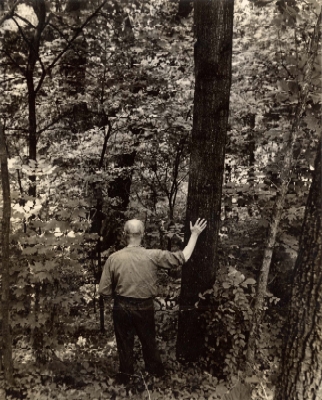 Aside from their insights into 20thcentury
journalism, conservation and
Latin American relations, the Wallace
papers also provide valuable material
for scholars of Kentucky politics, the
New Deal era,
World War II and
race relations. In
a sense, Wallace’s
work as editor
put him at the
crossroads of nearly
every important
event and issue
during the first half
of the 20th century.
Aside from their insights into 20thcentury
journalism, conservation and
Latin American relations, the Wallace
papers also provide valuable material
for scholars of Kentucky politics, the
New Deal era,
World War II and
race relations. In
a sense, Wallace’s
work as editor
put him at the
crossroads of nearly
every important
event and issue
during the first half
of the 20th century.
In 1951, at the pinnacle of his long career, Wallace decided to donate his personal papers to The Filson, where he had been a longtime member. Although The Filson did not receive his papers until 2001, Wallace’s foresight and concern for preserving history have made this important 20th-century collection available to future researchers. When considering donating your personal papers, please keep The Filson in mind because, like Wallace, “preservation is our purpose.”
The Filson Historical Society
1310 South Third Street - Louisville, KY 40208
Phone: (502) 635-5083 Fax: (502) 635-5086
Hours
The Ferguson Mansion and Office
Monday - Friday: 9 am. - 5 pm.
Saturday and Sunday closed
Library
Monday - Friday: 9 am. - 5 pm.
Saturday: 9 am. - 12 noon
